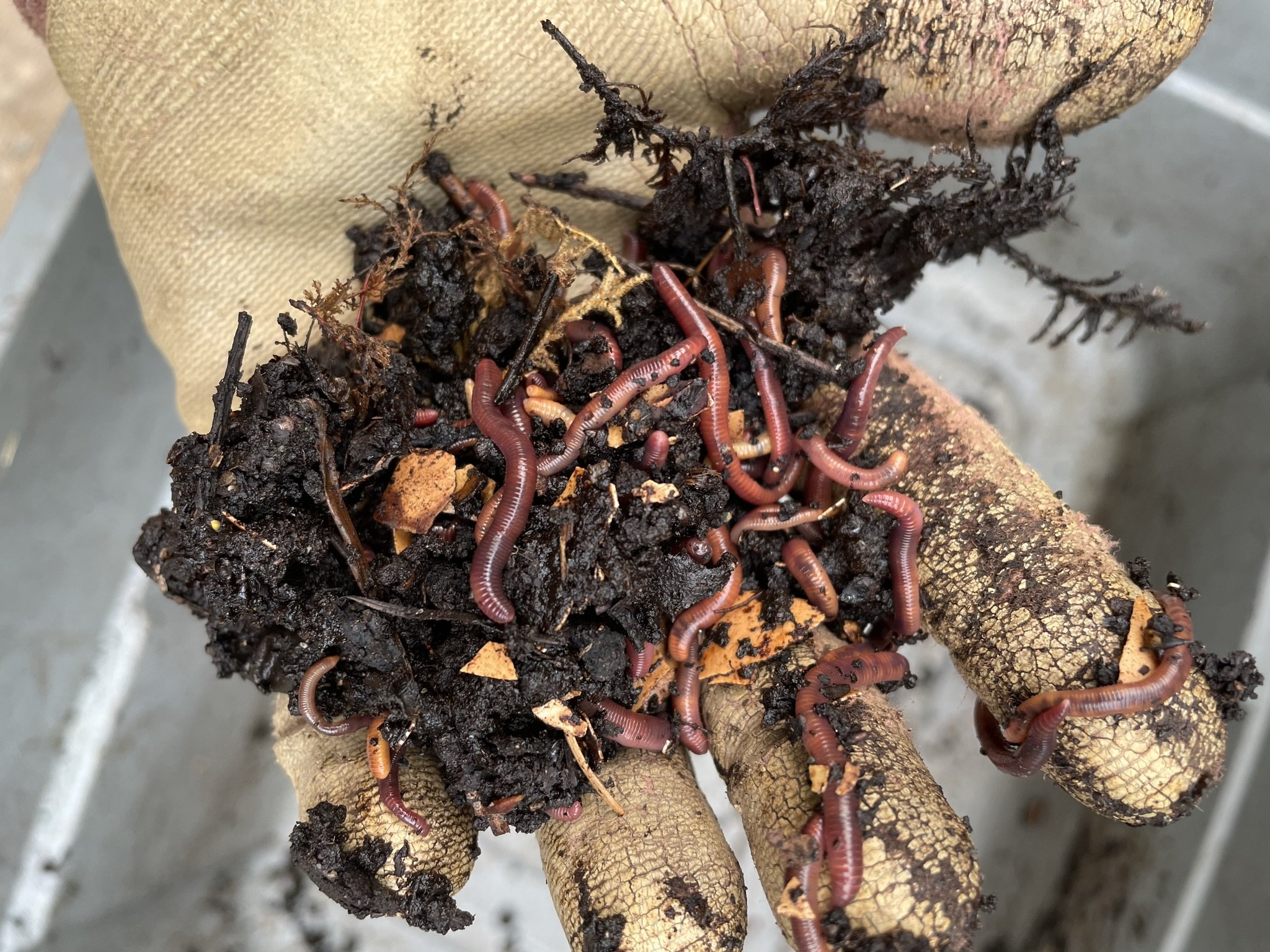Making a Compost Pile
A good gardener knows the importance of healthy soil. Home-made compost is an excellent way to build the health of your soil and grow healthy plants!
What is compost? Compost is a nutrient-rich soil amendment that is the result of bacteria, fungi, microbes, and invertebrates eating, digesting, and breaking down organic matter. Compost feeds the soil slowly and releases nutrients steadily, allowing the soil to feed plants. The benefits of compost are more than nutritional; compost also improves soil structure, and simultaneously improves drainage and water retention.
What are some different composting systems?
Cold composting: Create a heap and let it be. Having the correct recipe of green and brown materials is essential for creating the right bacterial activity in a hot compost pile, but in slow composting a heap of yard waste is left alone, and mesophilic bacteria, insects, and fungus will slowly decompose the material over time. In a cold compost heap it is important to be aware of adding too much nitrogen, or the pile will become stinky. Ideally use a variety of ingredients in your compost pile (leaves, grass clippings, cardboard, woodchips, plant debris) to increase airflow and bacterial activity.
It is important to note that this composting system does not generate enough heat to kill weed seeds and plant pathogens, but it requires the lowest amount of inputs.
Hot (thermophilic) composting: Many composting systems are based on providing the optimal conditions for this type of composting system. The high temperatures of thermophilic compost piles are effective at breaking down organic matter quickly into weed-free and disease-free nutrient-dense compost. What to learn more about hot composting? Click here.
Other Composting Systems
Vermicompost
Vermicomposting: This is the preferred method of composting food scraps (at least preferred by this writer) because it produces vermicastings, which is more nutrient-rich than compost. The major focus of vermicomposting employs certain earthworms to assist with fragmentation, mixing, and aerating of the waste materials. This process is achieved by adding food scraps to “worm bins”, then harvesting the vermicastings. This is a more intensive, smaller-scale type of composting, and relies on a healthy population of red wrigglers to breakdown organic material.
Bokashi composting: This is an anaerobic fermentation process that relies on inoculated bran to ferment kitchen waste, including meat and dairy, into a safe soil builder and nutrient-rich tea for your plants.
Tumbling compost systems: This is a form of aerated composting which relies on naturally-present decomposition microbes to digest organic waste and turn it into finished compost.
What should I add to my compost pile?
For organic materials to decompose into garden gold, gardeners should try to create an environment ideal for the microbes, invertebrates and other organism that are doing the work of decomposition. The recipe is simple: a variety of brown and green ingredients, moisture and air.
In a cold compost pile the recipe is not as specific because speed is not a priority. It is still important to have a variety of green and brown materials though, or else your pile of yard waste may take a very long time to decompose, or it can become smelly.
In a hot compost pile aim for a ratio of 30 parts carbon (brown) to 1 part nitrogen (green) by weight to encourage microbial activity.
Compost Recipe
Green Ingredients: Compost ingredients containing nitrogen are known as green ingredients. They are soft, leafy, high in nitrogen, usually moist, and are low in fibre. Kitchen peelings and food wastes are mostly green. They lead to high temperatures. Some green ingredients such as coffee grounds and horse manure look brown, but because they are high in nitrogen they count as a brown ingredient. Our favourite green ingredients are: manure, grass clippings, coffee grounds, and kitchen scraps.
Brown Ingredients: Compost ingredients containing carbon are know as brown ingredients. They are fibrous, drier and more woody than leafy. Our favourite brown ingredients are: wood chips, straw, leaves, and cardboard.
Some ingredients are brown and green, especially when it comes to clippings from the garden. Fresh leaves are green, but stems are brown.
Moisture: Initially a compost pile with a moisture content of 50-60% by weight is optimal for microbial growth. In the summer it may be necessary to water your pile to increase moisture. In the winter it is recommended to tarp compost piles to prevent them from becoming water-logged and leaching nutrients. A three-bay compost system is useful because it can be constructed for optimal airflow. If your compost pile has a lid, there should be holes in the lid.
Air: The bacteria that break down the compounds in our pile require oxygen to metabolize the “waste” material. This is why layering ingredients is important. Adding too much of one ingredient at once can cause the pile to become anaerobic. If you have a lot of one material, turning that material into the pile is recommended.
How big should my compost pile be?
To ensure sufficient heat and moisture retention a pile should be at least 1 meter cubed in size. A three bay system created with cardboard-lined pallets is a commonly used and effective set-up for home gardeners.
In a three bay system, one bin is filled with the correct ratio of green and brown materials. Once this bin is full, fill the second bin. In hot composting the third bin is left open for turning the third bin. In cold composting, the third bin can be filled up. Depending on how quickly or slowly you fill up
To turn or not to turn?
Turning the compost pile can be beneficial by mixing the undecomposed organic matter from the outside of the pile into the center of the pile. This fresh material and aeration increases thermophilic bacteria activity and speeds up the decomposition process.
For large-scale compost makers turning compost piles is done with a machine. For homeowners, turning the pile from one bin to another with a pitchfork is a more common approach. Generally one, well-time turn is all that a small scale operation requires.
What’s going on with my compost pile?
Why is my compost pile stinky? When there are too many green ingredients and nitrogen is too high (or carbon ratio is too low) decomposition will be fast, but excess nitrogen will be lost as ammonia gas, making a stinky pile.
My compost pile is taking forever to decompose. What can I do to speed up decomposition? The most likely issue is that the carbon level is too high in your pile. When there is too much carbon there will not be enough heat generating bacteria and the decomposition process is very slow. The best thing to do is to turn my green ingredients into your pile to encourage more microbial activity.
What happens if my pile it too dry? When the pile is too dry, decomposition will slow because bacterial growth is inhibited.
What happens if my pile is too wet? When the pile is too wet, decomposition will slow because there will be anaerobic pockets in the pile. Nutrient leaching also occurs when a pile is too wet. The pile should be moist enough that when you take a handful of compost you cannot squeeze water out of it, but it should have some moisture.
Why is good air circulation important? Just like humans, microbes use oxygen and produce carbon dioxide. This is one reason why layering ingredients is important. It’s best to add different types of ingredients that are different sizes to allow air movement in the pile.
What happens when there isn’t enough oxygen in the pile? If there is not enough oxygen in the pile, the composting process becomes anaerobic and the pile will become sticky. The pile will become anaerobic. The best solutions are to turn your pile regularly, and ensure you are adding ingredients that are different sizes to create air pockets.
I want to try to make a hot (thermophilic) compost pile. How does it work?
Create a pile of organic material that has a ratio of 30 parts carbon (brown) to 1 part nitrogen (green) by weight. The pile should be at least 1 meter cubed in size. At this point the mesophilic bacterial activity will begin.
1. Mesophilic/moderate-temperature phase (up to 40°C)
Typically lasts for a couple of days
Mesophilic bacteria break down soluble, readily degradable compounds and the heat they produce causes the temperature of the compost pile to rapidly rise.
Once the temperatures exceed 40 degrees Celsius the mesophilic bacteria are replaced by heat-loving thermophilic bacteria.
2. Thermophilic, or high temperature phase (over 40°C):
Can last from a few days to several months depending on the size of the system and the composition of the ingredients.
Thermophilic bacteria break down proteins, fats, and complex carbohydrates like cellulose and hemicellulose, the major structural molecules in plants. Turning the pile during this phase will extend the amount of time the thermophilic bacteria are active. Temperatures of 50 degrees Celsius and higher will kill weed seeds.
Once these compounds are broken down, the thermophilic bacteria activity decreases, along with the heat of the compost pile.
3. A several-month mesophilic curing and maturation phase (below 40 °C)
Includes a high amount of beneficial invertebrate activity: sowbugs, centipedes, slugs and snails
Chemical reactions continue to occur that make the remaining organic matter more stable and suitable for plant use.
When the compost is cured (it’s temperature is only 10 degrees Celsius above ambient temperature) it can be applied as a top-dressing to gardens or used as a soil amendment.




